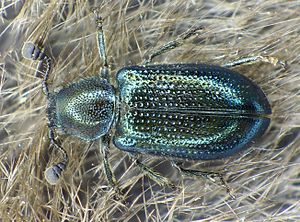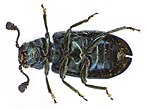Blue spotted beetle
| Blue spotted beetle | ||||||||||||
|---|---|---|---|---|---|---|---|---|---|---|---|---|

Blue spotted beetle on dead mouse |
||||||||||||
| Systematics | ||||||||||||
|
||||||||||||
| Scientific name | ||||||||||||
| Necrobia violacea | ||||||||||||
| ( Linnaeus , 1758) |
The blue beetle , also blue ham beetle , ( Necrobia violacea ) is a beetle from the family of the beetles and the subfamily Korynetinae . The three European species of the genus Necrobia can all also be found in Central Europe and can be easily distinguished by their color. However, there is a risk of confusion with Korynetes caeruleus .
The beetle, which is widespread worldwide, is not considered endangered in Germany.
Notes on the name
The species name violacea (from Latin "violācĕus, a, um" for "violet") names the blue color of the beetle. The generic name Necróbia is after Schenkling from Altgr. νεκρός nekrós, dead and βίος. bíos, place of residence, and means that the representatives of the genus live on or in substances of animal origin. According to French sources, the name (νεκρός nekrós the dead, βίος bíos life, "the life of the dead") commemorates the fact that the beetle Necrobia ruficollis saved the life of the French entomologist Latreille . Latreille was one of the conservative Catholic clergy who refused to recognize the civil constitution of the clergy during the French Revolution and he was to be deported to French Guiana for this. In 1794 in the prison of Bordeaux he found the beetle, still unknown to him and described by Fabricius in 1775 as Dermestes ruficollis , and was therefore able to establish a connection with the young coleopterologist Bory de Saint-Vincent through the prison doctor . With the involvement of various personalities, this succeeded in obtaining the release of Latreille at the last minute. He had already been taken to a ship and was able to get off it on a rowboat just before it sank, killing all of the prisoners. When the species was separated from the genus Dermestes in 1795 , the new genus was named Necrobia by Olivier .
The name "blue ham beetle" can be explained in such a way that the species, in contrast to the red-legged ham beetle Necrobia rufipes , which occasionally occurs on ham, is also blue on the legs. The part of the name "piston beetle" can be explained by its piston-shaped antennae and its affiliation with the beetles.
The species has numerous synonyms .
- Corynetes chalibea Storm 1837
- Corynetes dalamatina Obenberger 1916
- Corynetes jablanicensis Obenberger 1916
- Clerus quadra Marsham 1802
- Corynetes angustata Faldermann 1835
- Necrobia errans Melsheimer 1846
Characteristics of the beetle
The beetle is only four to five millimeters long. It is about 2.5 times as long as it is wide, slightly arched, and shiny metallic blue to blue-green or green, also on the legs. It has long protruding hairs, sometimes with different types of hair (double hair).
The triangular head with the bulging eyes is lowered and can be pulled back a little into the pronotum. The end link of the jaw probe is not ax -shaped as in Korynetes , but spindle-shaped and trimmed (Fig. 5 next to the feeler base and Fig. 1). The eleven-part antennae (Fig. 5) are black throughout and end in a three-part, very broad and flattened club. Its end link is significantly larger than the penultimate link and the club is more compact than the club of Korynetes .
The throat plate is similar to Korynetes not uniform convexly rounded, but it widens to the rear relatively straight up to the last third and there is significantly wider than the head. The base is convex and ends laterally protruding in acute back angles. The base and sides of the pronotum are edged off. The pronotum is coarse and densely dotted , more dense than the pronotum of Korynetes violaceus .
The elytra are together wider than the pronotum, widen only slightly towards the shoulders and reach the greatest width in the rear half. They end together with a rounded semicircle. They carry rows of elongated dots, which are strongly developed in the front half, which expire towards the end of the elytra. The hairiness of the wing covers is clearly double. Between bristly, dark and long hair, which is slightly inclined forward, there are denser, shorter, lighter, thinner and clearly reclined hairs (Fig. 4). The pronotum is also double haired. However, it is difficult to see the very fine, light hair between the long, dark hair standing in front (Fig. 1).
The hairy legs are blue to black, not red or brown. The tarsi are all five-limbed, but appear to be four-limbed, as the fourth limb (red in Fig. 6) is very small and is hidden in the cavity of the third limb at the base of the claw limb. The claws are serrated at the base (Fig. 6).
The male's sexual apparatus has been described. External gender differences are not known.
larva
The larvae (picture under web links) are elongated and have three jointed pairs of legs. Only the head, the first breast segment and part of the last abdominal segment are sclerotized, the remaining segments are soft-skinned and marbled. The end of the abdomen has a pincer-shaped appendix, the urogomph. This arises from a sclerotized plate, which leaves the base of the last abdominal segment free and has no pregomph in front of the urogomph. The inner edge of the upper jaw is not serrated. The lower jaw is only slightly retracted under the head. Cardo and stipes are about the same size.
biology
The adults occur wherever remains of carrion can be found. The species prefers dry bones, fur with leftover meat or dried up carrion and dried fish. It is not uncommon to find it on feed meal, hides and animal skins, smoked meat and bacon. The beetle is also regularly found in forensic examinations of older corpses lying in the open air. In contrast to Necrobia rufipes , however, the larvae do not eat the carrion or food of animal origin, but instead feed on insect larvae that develop in the carcass and in meat products. They are therefore useful and not classified as pests. According to other observations, they have the same food preferences as the fly Piophila casei and can also feed on the decomposition products of animal tissues.
In a study of carcasses in various forest types in Poland, the beetle was detected from spring to autumn, regardless of the type of forest, but mainly in spring. Larvae were only found in spring. When comparing carcasses in the forest and on the meadow, the beetle was found preferentially in spring and summer on meadows on carcasses that were already dry.
In investigations in Switzerland, the adults appeared during the fourth stage of decomposition (ammoniacal putrefaction) and were found until the carcasses had completely dried up. This corresponds to a period of five to nine months after death, which is why the presence of the beetle on a carcass has little informative value for forensic entomology . The species has also been observed on a ten-day-old carcass. For Spain, the appearance of the adults is already given for the third stage of decomposition (fermentation with cheese-like products) and a duration of 25 to 35 days is assumed for the development time of the beetle larvae.
Laboratory tests have shown that the larvae eat their way into the pupae of flies of the genus Sarcophaga . The entrance holes were partly sealed by a secretion, partly they remain unsealed. Active and inactive larvae and pupae of the blue spotted beetle were found in the sealed pupae, while larvae and adults were found in unsealed pupae. Finding beetles in larval-less meat, however, suggests that the beetle may also be consuming rotting meat.
distribution
The originally Palearctic species is distributed worldwide today. It just avoids very cold areas.
literature
- Heinz Joy, Karl Wilhelm Harde, Gustav Adolf Lohse: The beetles of Central Europe . tape 6 : Diversicornia . Spectrum, Heidelberg 1979, ISBN 3-87263-027-X .
- Klaus Koch : The Beetles of Central Europe Ecology . 1st edition. tape 2 . Goecke & Evers, Krefeld 1989, ISBN 3-87263-040-7 .
Individual evidence
- ↑ a b Necrobia violacea in Fauna Europaea. Retrieved December 18, 2012
- ↑ Necrobia at Fauna Europaea. Retrieved December 18, 2012
- ↑ ARGE SWD Coleopterologists, profile on Art
- ↑ Sigmund Schenkling: Explanation of the scientific beetle names (species)
- ↑ Sigmund Schenkling: Explanation of the scientific beetle names (genus)
- ↑ Luc Auber: Coléoptères de France Fascicule II Edition N.Boubée & Cie, Paris 1953
- ↑ Necrobie in the French online lexicon ( Memento of the original from June 30, 2013 in the Internet Archive ) Info: The archive link has been inserted automatically and has not yet been checked. Please check the original and archive link according to the instructions and then remove this notice.
- ↑ Senem Özdemir and Osman Sert: Systematic Studies on Male Genitalia of Coleoptera Species Found on Decomposing Pig (Sus Scrofa L.) Carcasses at Ankara Province Hacettepe J. Biol. & Chem., 2008, 36 (2), 137-161
- ↑ J. Richard Gorham (Ed.): Insect and Mite Pests in Food United States Department of Agriculture, Agricultural Handbook No. 655, 1991 as PDF
- ↑ Heinz Freude , Karl Wilhelm Harde , Gustav Adolf Lohse (ed.): Die Käfer Mitteleuropas (= Käfer Mitteleuropas . Volume 1 : Introduction to Beetle Science ). 1st edition. Goecke & Evers, Krefeld 1965, ISBN 3-8274-0675-7 .
- ↑ a b Concha Magaña: La Entomología Forense y su aplicación a la medicina legal, Data de la muerte Aracnet 7 -Bol. SEA, nº 28 (2001): 49-57 as PDF
- ↑ Sz.Matuszevski, D. Bajerlein, Sz. Konwerski, K. Szpila: Insect succession and carrion decomposition in selected forests of Central Europe. Part 2: Composition and residency patterns of carrion fauna , Forensic Science International 195 (2010) 42-51
- ↑ Petr Kočárek: Decomposition and Coleoptera succession on exposed carrion of small mammal in Opava, the Czech Republic European Journal of Soil Biology 39 (2003) 31-45
- ↑ Claude Wyss: Entomologie forensique Science ou utopie Sud-Ouest Nature, Revue Trimestrielle de la SEPANSO, No. 129, May 2005. as PDF
- ↑ R Elmallakh: Food Source For Necrobia violacea (Coleoptera Cleridae) Entomological News 89, 7 & 8, p. 178, 1978 ISSN 0013-872X [1]





